With a self-professed desire for perfection, one grower in Scotland has invested in an impressive nine precision agriculture systems in order to help drive on-farm efficiency. CPM finds out more
Particularly in these crazy times, we’re realising the value and importance of connectivity.
By Charlotte Cunningham
In East Lothian, Haig Hamilton and his eight-man team of operators are busily working through a heavy spring workload across the 1538ha he covers at both his home farm, and through contracting work.
Potatoes make up the biggest proportion of cropping here, with the mixed Scottish soils producing supplies for Tesco, Morrisons and Asda all over the country. As well as this, Haig also grows winter wheat and winter barley for feed markets, while his oilseed rape crop heads south.
With a fairly sizeable workload and catchy weather patterns dictating uptime, Haig made the decision to invest in his first precision technology system in 2005, in a bid to help lessen the load by being more precise. His system of choice – a John Deere StarFire RTK. “I was approached by our local dealer to see if I would be interested in trying one, and it all went from there,” he says. “I’ve always liked perfection and with a growing business it made everything so much easier and more accurate.

With a growing business, Haig Hamilton says Starfire made everything much easier and more accurate.
“We were increasingly trying to farm a bigger area of land, but with less time, so it made sense. It’s turned out to be a really beneficial tool to have.”
So how does it work?
A mobile RTK correction signal is transmitted via cellular technology. This provides repeatable accuracy, even in scattered fields and in hilly terrain, explains Will Hutchison, group integrated solutions manager at Haig’s local John Deere dealership, Thomas Sherriff. “The Mobile RTK Modem 4G LTE is fully integrated and attachable to the StarFire receiver, with two high performance antennas and the mounting position on the cab roof, users can benefit from optimal reception and signal stability.”
It not only supports the latest 4G LTE mobile communication standard, but also 3G – as well as 2G as the fallback solution – adds Will. “There’s also a feature called RTK-X that allows the SF6000 receiver to hold onto RTK accuracy for up to 14 days as the fallback solution.
“In addition to the mobile RTK functionality, the modem can also be used in parallel as a WLAN hotspot to connect with your mobile devices.”
Taking his love for precision to the next level, two years ago Haig invested in passive implement guidance on his 8RT tracked tractor which works with a long-trailed drill. “We demoed it on the drill and straight away we could see a huge difference – everything was 100% bang on, and the drill was exactly where it should’ve been,” says Haig.
To quantify this, when the farm was manually sowing at 24m, accuracy was anything from 4-6% out. “Now, 24m means 24m exactly,” he explains. “Using an average of 5% inaccuracy every time we were sowing a crop, that means I’m directly saving 5% of our time, diesel, fertiliser and sprays – it’s a win-win situation.”
Fast forward to 2020 and Haig has gone from one RTK to four, as well as investing in five SF6000s on the basic SF1 signal. With a rather impressive nine systems – seven on tractors and two on implements – Haig says it’s most beneficial in potato production. “Every single bit of kit has got the John Deere kit on it and it makes things simpler at every stage – from planting to lifting.”
According to Will, efficiency is something that customers are actively looking for when it comes to machinery purchases. “It’s very rare now that a tractor goes out without a receiver on it. They’re essential for maximising the efficiency of every aspect of operations – even down to how you turn in a field.”
John Deere’s new generation StarFire 6000 satellite receiver was introduced to the market in 2016 as the successor to the StarFire 3000 receiver.
Boasting a number of advantages over the 3000 model, the new receiver came available with an improved, free SF1 correction signal (+/-15cm, reduced from 23cm), and an all-new SF3 signal with +/-3cm pass-to-pass accuracy, as well as a number of major RTK (+/-2.5cm) innovations.
Perhaps rather interestingly, while more accurate signal correction software is available, Haig’s SF1’s doesn’t mean compromised performance, explains Will. “While precision ag technology has been widely adopted by most manufacturers now, one aspect that’s fairly unique to John Deere is the tractor-to-implement connectivity.
“For example, if a grower wants to run a receiver on the tractor and on the implement behind, with the John Deere system you don’t have to have an RTK unlocked on each receiver. The machine’s receiver has to be RTK, but the implement only needs SF1 and using John Deere’s shared signal we have RTK accuracy at both. The biggest benefit of this is the cost-saving aspect and equates to a saving of around £5000/per unit.”
With eight full time staff, getting everyone to optimise the technology to its full potential may sound like something of a challenge, however, Haig says his team adapted easily and were quick to see the benefits of the systems. “It was a big move – and a big investment – but they’re all agreed on the fact that it makes their lives easier from an operator’s point of view.”
And from a managerial perspective, it’s also advantageous, he adds. “I use John Deere’s MyOperations app every day, and as I refresh my screen now, I can see that it was updated just 57 seconds ago.
“If I look specifically at one of my operators, I can see that at this moment in time he’s got 76% fuel left. I can see his average forward speed and I can also look on the map to see how much of the field he’s covered so far. Having access to this makes organising a big team in a tight timeframe very straight forward.”
While his increased precision and efficiency is an obvious win for Haig and his team, his customers are impressed, too. “I think customers see it as a benefit too. Well, I haven’t had anyone say they don’t want it at least,” he laughs.
Maximising uptime with dealer support
Minimising downtime is a necessity for both his home hectares and his contract work, and Haig says the support from his local dealership – Thomas Sherriff – has been integral in helping him keep his kit running. “Obviously, like any kind of technology, there are sometimes hiccups. However, I get 100% backup service and it makes life a lot easier if there are any issues.
“Will Hutchinson and his team have been happy to spend time with us and with our operators to ensure we fully understand the system and know how to get the best out of it. If it wasn’t for them, this system wouldn’t have been so successful.”
As well as the John Deere PowerGard Protection Plus scheme – which covers the majority of the machines – Haig also benefits from Sherriff’s-own extended warranty plan. “Haig likes to work with fixed costs, but unfortunately the industry hasn’t yet developed a machine that doesn’t breakdown,” explains Will. “However, having this fully comprehensive package means absolutely everything – including all of the servicing – is costed at the time of purchase, meaning no nasty surprises or unexpected costs.”
All machines also have a Sherriff Ultimate AMS support package which offers benefits including:
- Priority access to the Precision Ag support hotline and support app
- AMS equipment updates
- Access to pre-season training
- GreenStar display documentation and MyJohnDeere support
- Out of season setup visit
- Back-up AMS components
- In-field support/optimisation visit
While Haig’s experience proves the value and effectiveness of the precision kit, what’s more important is ensuring that customer service matches the ability of the product, adds Will. “For us as a business, customer support is key and if we don’t have the technology to allow us to connect with our customers at any time of the day then it doesn’t matter how good the product or service is we’re trying to sell.
“Customers are everything and it’s nice to have such great tools from John Deere that helps us stand apart from the competition.”
Game-changing connectivity
Looking to the future, Will believes John Deere’s Connected Support strategy will be a real game-changer for both the firm and its customers. “Particularly in these crazy times, we’re realising the value and importance of connectivity.”
But how exactly does Connected Support work? “If the machine produces a diagnostic code during operations, it’s delivered via JDLink Telematics and sent to the dealership’s monitoring centre. The dealership can then diagnose the code and get in touch with the customer,” he explains.
All of Haig’s machines are consented for Maintenance and Expert Alerts and the workshop proactively contacts him for all planned maintenance using the service admin portal dashboard, adds Will. “This system will also point out any Expert Alerts so we can proactively make repairs prior to machines having to stop. This gives Haig more uptime.
“Both Haig and ourselves use Remote Display Access from dealer to machine for operator support and training, and all data is sent from all machines – logged as applied data – back to his Operations Centre account.
“Especially now, everything has to be connected and I’m very glad that John Deere had the foresight to develop such tools that means we’re able to be right there in the cab with the grower, even at a time when we are physically are unable to do so.”
Farm facts
J Haig Hamilton and Sons, East Lothian
- Arable area: 1538ha (324ha owned, the rest contracting and rented ground)
- Cropping: Potatoes, winter wheat, winter barley and OSR
- Soil type: Mixed soils – from sandy loam to clay loam
- Mainline tractors: John Deere 8400R; 7310R; 8335RT; 6250R; 6175R; 6175R
- Combine harvester: Claas Lexion 780
- Cultivations: Simba 8.2m Unipress, 6m Amazone power harrow, 5m Sumo Quattro, 2x Lemken 6f on-land/in-furrow ploughs
- Drills: 6m Lemken and 4m Lemken
- Sprayers: Sands 36m 5500-litre tank
- Staff: Family partnership between Haig, his two brothers and his mother and father, as well as eight full-time members of staff.




